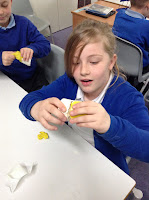- Mould fossils form when all the parts
(including the bones) have decayed and all that is left is the mould of the
animal. Cast fossils form from mould fossils as
the mould fossil is filled up with sediment – so it is not made up of the
original matter of the animal or plant.

- Replacement fossils form when water dissolves the original hard matter of the bones and replaces them with mineral matter – this is what we think of when we discuss dinosaur fossils. They still look like the original bones but are not made up of the same matter.


- Whole body fossils form when the original body has been preserved – for example a woolly mammoth in ice or a mosquito in amber.


These photos really capture the WOW moment!















No comments:
Post a Comment
To help ensure anonymity for all our children please don't use surnames when posting comments. Use first names or names such as 'Susie's mum' when commenting. Please make sure all comments are polite and kind.